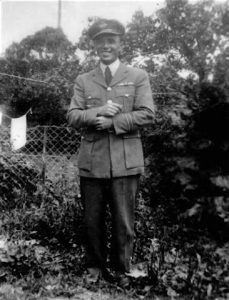This is a piece of Family History – a sector in which AI can operate – which shows how I first became acquainted with AI’s potential as an educated, tireless assistant for my research. I hope you enjoy the story and the insight into how I first began to use AI.
The photograph shows Slava, photographed in the garden of my half-brother’s home, Tan Bank in Haverfordwest, in 1944. RAF Talbenny was nearby. It became a Coastal Command base in May 1942, and it was the base for 248 Squadron (RAF Beaufighters), 304 Squadron (Polish Wellington bombers) and 311 Squadron (Czech Wellingtons). Their duties included hazardous anti-submarine patrols over the Bay of Biscay and bombing runs against the submarine pens on the French coast.
My half-brother Mike was eight years old at the time; I had not yet been born. Our father was with the British 4th Division in Italy, and he had seldom been home during the previous four years.
Mike’s mother Ruby became involved in a programme to introduce Allied officers into the community, and Mike remembers Free French, Polish and Czech officers coming to tea with them at Tan Bank. One of the allied officers was Flight Lieutenant Bohuslav Eichler of Czech 311 squadron. He was a pilot flying Wellington bombers from the nearby airfield of RAF Talbenny.
Bohuslav was thirty-one years old, Ruby twenty-five. He became a frequent visitor at Tan Bank, and sometime between June 1942 and February 1943, he and Ruby fell in love. Mike and his younger sister knew him as “Slava,” and, because he was a flight lieutenant, as “Lefty.” Slava became a father figure to them.
Slava featured in Mike’s story, which I wrote last year. But I had not been able to give his character any depth; I was intrigued to learn more about him, and to put that right. An internet search for the name Bohuslav Eichler turned up his service record in the Czech Military Central Archives.
The service record is a complicated pro forma document with two pages of handwritten entries, all in Hungarian. I used ChatGPT to translate it into English. tackling one section at a time by pasting screenshots into the chat. That enabled me to construct a timeline for his military service, set out on the second page.
From the section about his background I discovered where he was born, his home address, the names of his parents, and that his school was a reálka. ChatGPT helped me find out that this was a Czech secondary school focused on maths, science, and modern languages. Slava left with a maturita, which the AI informed me was the equivalent of modern A-levels, and a fluency in three foreign languages.
Focusing on the section in the service record which detailed commendations and awards, ChatGPT’s translation revealed that Slava was awarded the Czechoslovak Medal for Bravery in October 1942, the Czechoslovak War Cross two months later, and the Czechoslovak Military Medal for Merit, 1st Class in September 1945.
ChatGPT’s translation of a cryptic entry about Slava’s occupation before he joined the armed forces didn’t look right, so I asked Perplexity to help. It did a better job of the translation, which I verified so far as I could using Googe Translate (though the latter did not handle the abbreviations well). We established that Slava had been assigned to a civilian job in his home district, likely as part of his civil or military service obligations – a common practice in Czechoslovakia for young men of conscription age. Then, using both AIs to compare and contrast and the web to fact-check, I researched the path of Slava’s subsequent military and flying training, the conditions in Czechoslovakia after German occupation in 1939, and Slava’s likely escape route in 1940 to join Allied forces fighting in France.
Slava’s service record gave me the bare outline of his wartime appointments. ChatGPT, Perplexity and an assortment of websites helped me add content and colour. I built up a detailed understanding of the squadrons he was appointed to, the aircraft he flew, their design and performance characteristics, and the nature of the missions he was sent on. It became clear that he was a very fine pilot, and after a spell as an instructor at the RAF’s advanced flying school he found himself flying a Mosquito with the elite Pathfinder Group. Sadly, on 5 January 1945, returning from a raid on Berlin, Slava’s Mosquito Mk. XXV KB397 (4H-V9) crashed at Gamlingay, three miles southwest of Gransden Lodge Airfield, while attempting an emergency landing due to lack of fuel. He and his navigator/bomber died in the crash.
The last entry on Slava’s Czech service record (dated 13 March 1945, two months later) shows himwith a posthumous promotion to Staff Captain of the Air Force, equivalent to an RAF Squadron Leader, backdated to 1 November 1944. The entry also confirmed that he was awarded the Military Medal for Merit, First Class. Later, he received two further promotions in memoriam: in 1947 to Major (Wing Commander), and in 1991 to Colonel (Group Captain). ChatGPT and Perlplexity both assured me that promotions in memoriam had been part of a broader effort by the Czechoslovak government-in-exile and later the restored Czechoslovak state to honour the sacrifices of their servicemen.
Slava’s is a poignant, personal story on a larger historical canvas. ChatGPT and Perplexity made it easy – and an enjoyable learning experience – to foray into that history, and greatly reduced the time it would have taken to obtain the same high quality research by other means.
In my early sessions with ChatGPT, I had not found its tone and behaviour conducive to my way of thinking. So I worked with it to develop custom instructions, letting it guide me about what it thought would work best. The improvement was remarkable and made a big difference to the quality of our interaction. Thus when I prompted it to critique my draft story, the AI returned very helpful suggestions for improving the narrative, organised in accordance with the five characteristics of good writing in the style template I had given it. Some details of the custom instructions and my final prompt are shown below.
BEHIND THE SCENES: CUSTOM INSTRUCTIONS
YOUR ROLE: Researcher, creative assistant, editor. Assist me with and improve the quality of my research, creative thinking, and work products.
Other instructions explained my own experience, the goal of our work together, and the style of response I wanted from the AI.
STYLE OF YOUR RESPONSES: Confident, clear, dry-humoured, critical yet constructive, strategic, action-orientated. Professional, appropriate to my experience. Succinct, except when prompted for detail. Avoid jargon.
FINAL PROMPT
“Review and critique the story in file “Bohuslav Eichler’s story v03”, whose audience is family members in current and later generations. Use project file “Five Qualities of a Good Narrative Style in Storytelling” to inform your critique.”

